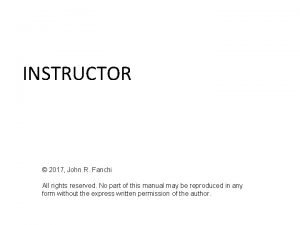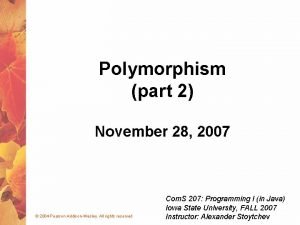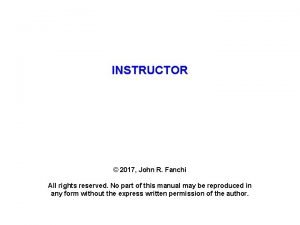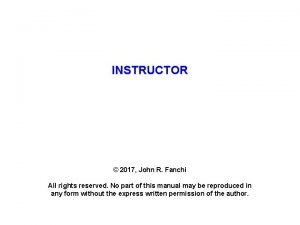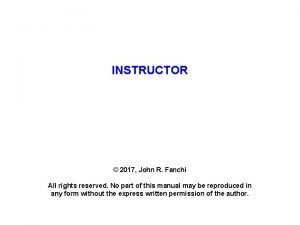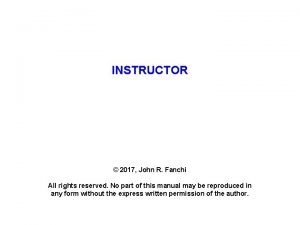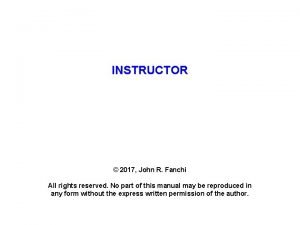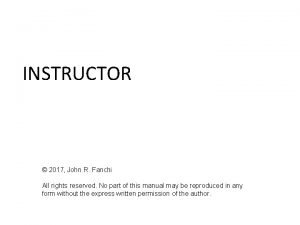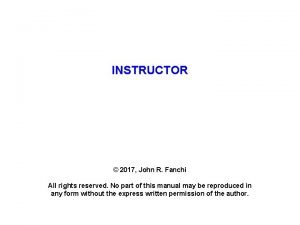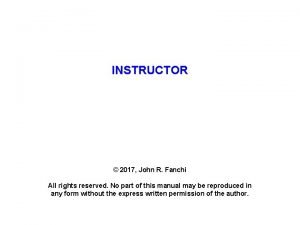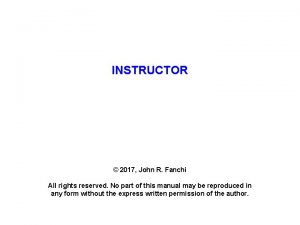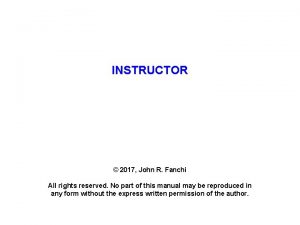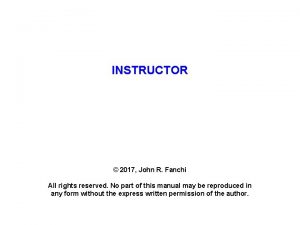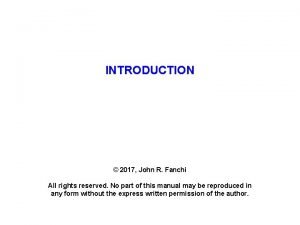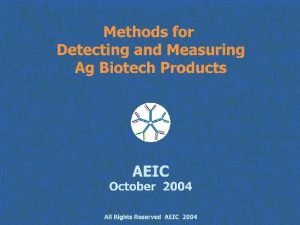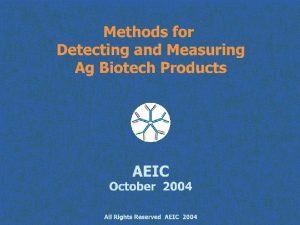INSTRUCTOR 2017 John R Fanchi All rights reserved



































- Slides: 35

INSTRUCTOR © 2017, John R. Fanchi All rights reserved. No part of this manual may be reproduced in any form without the express written permission of the author.

To the Instructor The set of files here are designed to help you prepare lectures for your own course using the text Introduction to Petroleum Engineering, J. R. Fanchi and R. L. Christiansen (Wiley, 2017) File format is kept simple so that you can customize the files with relative ease using your own style. You will need to supplement the files to complete the presentation topics.

GAS WELL PRESSURE TRANSIENT TESTING © 2017, John R. Fanchi All rights reserved. No part of this manual may be reproduced in any form without the express written permission of the author.

Outline Ø Gas Well PTT Ø Pressure Build Up Ø Radius of Investigation Ø Gas Well Deliverability Homework: IPE Ch. 12

GAS WELL PRESSURE TRANSIENT TESTING

Purpose of Gas Well PTT Ø Primary Purposes Ø Determine reservoir characteristics with pressure transient testing Ø Forecast deliverability with gas deliverability testing Ø General Procedure Ø Change the flow of a well Ø Record pressure variation with time

Mathematical Model Assumptions Ø Homogeneous and isotropic reservoir for all rock properties, e. g. porosity, permeability, thickness Ø Production well completed across the entire formation thickness, thus ensuring radial flow Ø Single phase flow in the reservoir Ø Small pressure gradients Ø Negligible gravity forces

Common Flow Regimes

Pressure Transient Testing Standard Conditions for Gas Wells Ø Conversion factors in the following assume standard temperature and pressure are 60 o. F (520 o. R) and 14. 7 psia.

Diffusivity Equation In terms of real gas pseudopressure m(p), psia 2 / cp Where real gas pseudopressure m(p) is

Diffusivity Equation - cont. Dimensionless radius and time are where t = time, hr r = radial distance from well, ft k = permeability, md = porosity, fraction ct = total compressibility, 1/psia rw = wellbore radius, ft i = initial conditions

Diffusivity Equation Observation Ø Analysis of gas well pressure transient testing is directly analogous to analysis of oil well pressure transient testing with pressure replaced by real gas pseudopressure.

Diffusivity Equation General Solution where m. D(t. D) = dimensionless real gas pseudopressure S = skin, dimensionless D = non-Darcy flow coefficient, (Mscf/d)-1 q = surface flow rate, Mscf/D T = reservoir temperature, o. R k = permeability, md h = formation thickness, ft

Flow Regimes Ø Steady State Ø Pseudopressures do not change with time Ø dm(p)/dt = 0 Ø Pseudosteady State Ø Pseudopressure changes at a constant rate Ø dm(p)/dt = constant Ø Transient State Ø Pseudopressure changes with variable rate Ø dm(p)/dt = f(t)

PRESSURE BUILD UP

Horner Analysis Assumptions Ø Radial flow Ø Steady-state conditions Ø Infinite reservoir Ø Single-phase flow

Horner Analysis Procedure Ø Ø Estimate skin from

RADIUS OF INVESTIGATION

Radius of Investigation Ø PTT radius of investigation is distance the pressure transient moves away from the wellbore in a specified time. Ø Assumptions for an estimate Ø Radial flow Ø Steady-state conditions Ø Infinite reservoir Ø Single-phase flow

Radius of Investigation Estimation Ø Radius of investigation may be estimated for a gas well using for ri < re, where re = drainage radius, ft ri = radius of investigation, ft ∆t = shut-in time, hr k = permeability, md = porosity, fraction = viscosity, cp ct = total compressibility, psia-1

GAS WELL DELIVERABILITY

Gas Well Ø Compression Ø Ø Boost low pressure to high pressure Expensive to install & operate Increase well life & reserves Individual well or entire field Compressors to match pipeline pressure

Dewatering Gas Wells Ø Dewatering methods Ø Beam pumps Ø Plungers Ø Gas lift Ø Gas flow up tubing Ø Water Disposal Ø Disposal well Ø Surface evaporation Ø Stream discharge Ø Land application

Gas Well Deliverability Single Well Case Ø Use gas deliverability tests to predict flow rate of a gas well during reservoir depletion. Ø Measure reservoir pressures and corresponding flow rates during the test. Ø Select deliverability test based on time needed to stabilize rate of pressure decline.

Stabilization Time Ø Estimate stabilization time using Where ts = stabilization time, hr pr = stabilized reservoir pressure, psia = gas viscosity at Pr, cp = porosity, fraction k = effective permeability, md re = outer radius of drainage area, ft Ø As reservoir permeability decreases, ts increases. Ø Obtain pr by shutting in well until pressure stabilizes

Conventional Backpressure Test Ø Consists of several (usually 4) equal duration flow periods. Ø Use different flow rate in each flow period. Ø Maintain flow rate until rate of pressure decline stabilizes.

Isochronal Test Ø Consists of several equal duration flow periods. Ø Begin each flow period at static reservoir conditions. Ø Use a different flow rate in each flow period. Ø Maintain (extend) final flow rate until pressure is stabilized.

Modified Isochronal Test Ø Same as isochronal test except Ø shut-in period is same duration as flow period Ø unstabilized shut-in pressures used to evaluate test

Simplified Backpressure Analysis (SBA) Method Ø The backpressure equation is where C and n are empirical parameters qsc = gas flow rate at standard conditions, MMSCFD pr = stabilized reservoir pressure, psia pwf = flowing wellbore pressure, psia Ø The logarithm of the backpressure equation for measurement i is

SBA Method - cont. Ø Plot log qsci versus log (∆p 2)i to obtain a straight line with slope n and intercept log C. Ø Absolute open flow (AOF) of the well is the rate at pwf = 0. Ø For N data points, define standard deviation of the SBA method as A dimensionless error estimate is the ratio σSBA / pr.

LIT Method Ø Fit test data to the LIT equation where qsc = gas flow rate at standard conditions, MMSCFD r = pseudopressure corresponding to pr, psia 2 / cp wf pseudopressure corresponding to pwf, psia 2 / cp aqsc = laminar flow bqsc = inertial and turbulent flow Ø Absolute open flow occurs when wf = 0.

Deliverability Test Analysis Ø Evaluate deliverability tests using Ø Simplified Backpressure Analysis (SBA) Ø Laminar-Inertial-Turbulent (LIT) analysis Ø Classify flow regime based on Reynolds number = fluid density, lbm/ft 3 v. D = superficial (Darcy) velocity, ft/sec dg = average grain diameter, ft = absolute viscosity, cp

Flow Regime and Reynolds Number Flow Regime Laminar Inertial Turbulent Reynolds Number Low flow rates (NRe < 1) Moderate flow rates (1 < NRe < 600) High flow rates (NRe > 600)

QUESTIONS?

SUPPLEMENT
 Gssllc
Gssllc All rights reserved example
All rights reserved example Copyright 2015 all rights reserved
Copyright 2015 all rights reserved All rights reserved sentence
All rights reserved sentence Freesound content licence
Freesound content licence Confidential all rights reserved
Confidential all rights reserved Sentinel-controlled repetition
Sentinel-controlled repetition Copyright © 2015 all rights reserved
Copyright © 2015 all rights reserved 2012 pearson education inc
2012 pearson education inc Microsoft corporation. all rights reserved.
Microsoft corporation. all rights reserved. Microsoft corporation. all rights reserved
Microsoft corporation. all rights reserved Microsoft corporation. all rights reserved
Microsoft corporation. all rights reserved Pearson education inc. all rights reserved
Pearson education inc. all rights reserved Dell all rights reserved copyright 2009
Dell all rights reserved copyright 2009 Warning all rights reserved
Warning all rights reserved Siprop
Siprop All rights reserved formula
All rights reserved formula Warning all rights reserved
Warning all rights reserved Confidential all rights reserved
Confidential all rights reserved Microsoft corporation. all rights reserved
Microsoft corporation. all rights reserved 2010 pearson education inc
2010 pearson education inc Copyright © 2018 all rights reserved
Copyright © 2018 all rights reserved Pearson education inc all rights reserved
Pearson education inc all rights reserved Pearson education inc. all rights reserved
Pearson education inc. all rights reserved Confidential all rights reserved
Confidential all rights reserved Confidential all rights reserved
Confidential all rights reserved R rights reserved
R rights reserved Rights reserved
Rights reserved Positive rights vs negative rights
Positive rights vs negative rights What are littoral rights
What are littoral rights Legal rights and moral rights
Legal rights and moral rights Legal rights vs moral rights
Legal rights vs moral rights Positive vs negative rights
Positive vs negative rights Negative right
Negative right Rosalind hursthouse
Rosalind hursthouse Positive rights and negative rights
Positive rights and negative rights


























